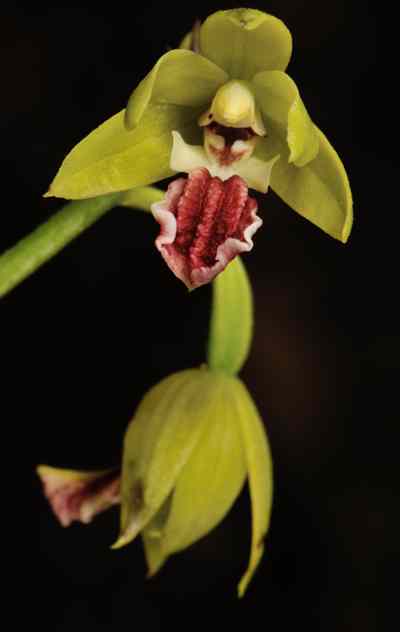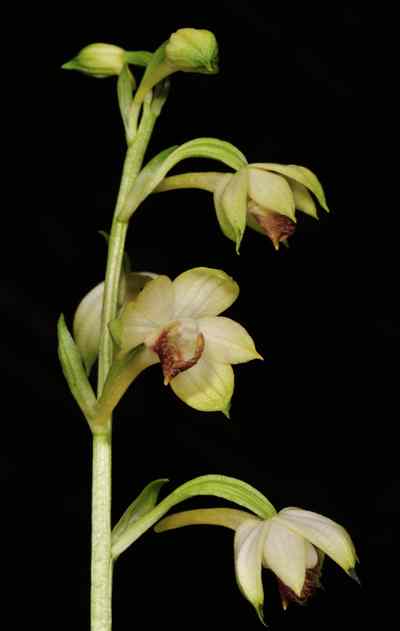The Plant
Terrestrial. Pseudo-bulbs small, less than 2 cm long, ovoid with conical apex, with several long stout roots arising from its base. Pseudo-stem about 2 to 3 cm long, sheathed with two lanceolate bracts, with the upper one more than twice longer than the lower smaller one. Leaves four to five, unequal with undulate margins and veined surface, elliptic, acuminate, narrowed to the sheathed base, 5 to 8 cm long and 2 to 4 cm in width. Flower many, laxly arranged, in a peduncle arising amongst the leaves, usually single rarely two. Peduncle much longer than the leaves, with an erect lanceolate bract around its middle. Raceme minute ribbed as well as puberulous.
The Flower
Flowers 2 to 3 cm across, facing diagonally down. Sepals unequal, lanceolate with broad base; dorsal erect; lateral longer than the dorsal, the basal margin curved upwards towards its upper side and spreading behind the ovary to form a sickle shape; dorsal and sepal three veined. Petals erect, very narrow, longer than the dorsal sepal, linear with pointed apex, spreading, one veined. The base of the lip adnate with the column, three lobed; basal diverging, oblong, blunt; the apical lobe broadly quadrate with short fimbriated margins and pointed tip, its base converging and extending to a narrow short broad linear base. The disc with two narrow short calli arranged between the basal lobes. Floral bract lanceolate, curved up, arising from the base side of the stalked and decurved ovary, shorter than the latter.
Sepals and petals translucent, pale lavender. The basal lobe of the lip pale pink, the dorsal with a triangular shade of the same colour with white margins and a long narrow white separation running through its middle. The disc with two long parallel irregular broken dark pink markings. The column yellow with dark pink markings. Ovary pale brownish pink. Floral bract green.

The Pursuit
In the first year of my orchid hunt of the region I planned to visit the location of this beautiful species. One of my local contacts in the region had seen this plant from a place quite far away from my base camp. Due to various reasons I missed that trip for a few months and was able to go for the hunt by the mid of September only. By that time it had bloomed and its seedpods were dry. When the habitat is located it will be only a matter of re-visiting it at the time of its bloom the next season. Hence, I was happy with my local contact for guiding me to make this find.
The next year I planned the trip in the month of June itself along with the start of monsoon rains. However, the long winding road to the location got blocked with several landslides and reaching the location turned out to be impossible. I tried several short cuts to bypass those landslides but without much success. I was really disappointed with the natural events. It is the worst nightmare for any explorer for not being able to reach the location of a find. Finally, after many efforts I decided to look for another locations for this species.
In the third year of my research, I was camping in a protected area during the monsoon months. The forests there were sub-tropical to sub-alpine and I was able to find many ground orchids from the region. But this species remained elusive. Inside the protected area there were two narrow streams. The steams were with full flow around the year. In summer because of the melting snow in the high hills, in monsoon due of rains and in winter due to several springs downstream. Those wet surroundings of the two streams are always home to several plants and ground orchids, especially annuals. I concentrated on the banks of one of the streams for this plant. I trekked along the banks of the stream on its entire length to look for this plant. As both the sides of the stream are of vertical steep mountains I was forced to walk in waist high waters of the river. This made the trek very difficult. The higher I went the denser the forest, with the presence of many wild animals that frequently visited the stream. I was always exposed to danger due to the wildlife. Camping inside the forest was impossible, which made me walk back to my base camp every day after my hunt. By the mid of July it was time to move to another place. I had only three more days at that place and I decided to move much deeper inside the forest to look for this species.
On the penultimate day, I took a route never ever used even by the forest patrol party. The new route took me so deep inside the forest and for the first time in my entire work in the region of Sikkim-Himalayas I encountered a leopard and a bear the same day, that also within a span of 15 minutes!!! I always felt that I get more courage to venture into deep forest after encountering wildlife. My instant courage helped me survey a vast area on that day and finally found this species, a set of 15 plants scattered over a small area under thick undergrowth. Of the 15 plants 4 were in buds. Buds means more and more visits to the place in the coming days. As I haven’t found this species from any other locations there were no other options other than visiting that location in the coming days. I never advocated the practice of others researchers who took plants to their homes and research laboratories to have it in flower. On the way back I made several reference points to negotiate my coming trips to that deep area. On comparison with the measurements of buds taken and that of the reference book made me understand that those buds will bloom within 7 to 10 days. As the species got many flowers and they bloom one by one from the bottom of the peduncle, if late by a couple of days also I will get one or other flower in bloom. The next day I moved to the new location. From there I visited this location on the ninth day and was accompanied by another researcher of the region. Even though he was not working on orchids, the locals of the region and I suspected that he collected many orchids for others. Hence, none were happy with his presence. But, sometimes due to compulsions I am in company of such personalities. We reached the location on the previous evening and rested at the base camp.
Early morning with pack lunch, we proceeded to the location. As we ventured very deep inside the dense forest, my friend was not willing to accompany us. His usual research trips were on the fringes of forests and he was not at all accustomed with wild life areas. Then it came from the horse’s mouth itself, that, “I want to return”. He tried several attempts to take my assistant along with him to safeguard his return journey. My assistant gifted him one of our lunch packs and said “namaste dhaju” (Dhaju means elder brother). After he disappeared from our eyes we proceeded to the location by taking reference from the markings we made on our last return journey. Till our friend was there with us we never discussed about the references we made for our journey as we feared he might pass on that vital information to plant collectors of the region. We reached the spot without much difficulty to see several of them in bloom. I selected the freshly bloomed flowers and made this wonderful photograph. Also, the in-situ study of the species made reveal many new characteristics of the species, which were not even described by the pioneers in their monumental work.
The return journey was also breathtaking, with a female leopard following us for almost an hour!!!
Reference:
King, G. & Pantling, R. (1898). The Orchids of the Sikkim-Himalayas. Ann. Roy. Bot. Garden. (Calcutta). Calanthe puberula Lindl., Page no 166.








